 |
PO Box 9021,
Wilmington, DE 19809, USA
E-mail: font@focusonnature.com
Phone: Toll-free in USA 1-888-721-3555
or 302/529-1876 |

Mammals
in North America
Noting those during
Focus On Nature Tours
from 1991 thru 2015
with an (*)
A List of Mammals in North America
both Land and Marine
compiled by Armas Hill
With 404 species of mammals in this list.
Photo at upper right: a SILVER-HAIRED BAT,
70 miles off the coast of New Jersey, during a FONT pelagic trip in September 2004.
Codes:
Mammals seen during FONT tours & pelagic trips
are noted in this list with the following codes in blue.
Otherwise, the codes for occurrences are in black.
AK:
in Alaska (inc. offshore)
AZ: in Arizona
BC:
in British Colombia, Canada
CA:
in California (inc. offshore)
CO:
in Colorado
DE: in Delaware (inc.
offshore)
FL: in Florida (inc.
offshore)
KS: in Kansas
MD: in Maryland (inc. offshore)
MX: in Mexico
NC: in North Carolina
(inc. offshore)
NE: in Nebraska
NJ: in New Jersey
(inc. offshore)
NF; in Newfoundland, Canada
(inc. offshore)
NM: in New Mexico
NY: in New York (inc. offshore)
TX: in Texas
VA: in Virginia
WA: in Washington State (inc. offshore)
WI: in the West Indies
WY: in Wyoming
(p): seen pelagically offshore
SPECIES CLASSIFIED AS THREATENED GLOBALLY:
(t1): critically endangered
(t2): endangered
(t3): vulnerable
(nt): classified as near-threatened
(ph): species with a photo in this FONT website

The widespread Red Fox
(photo by Doris Potter)
Links to Groups of Mammals in this List:
American
Opossums Armadillos
Rabbits
& Hares Squirrels
American Beaver Mice & Rats
North American Porcupine
Canines
Felines Bears
Procyonids (Raccoons
& Allies) Mustelids
Shrews & Moles Bats
Seals,
Sea Lions, Walrus
Even-toed Ungulates (Sheep, Goats, Bison, Musk Ox)
Pronghorn
New World Pigs Deer
Manatee Porpoises, Dolphins, Whales
Other Links:
A List & Photo Gallery
of Mammals of Eastern North America
Lists & Photo Galleries of Mammals in: Alaska Arizona
California
Colorado North
Carolina Texas
Washington State
A Complete List
& a Photo Gallery of North
American Birds, in 6 parts:
Part #1: Grouse to Anhinga
List #2: Condor to Shorebirds
List #3: Jaegers to Cuckoos
List #4: Owls to Flycatchers List #5: Shrikes to Pipits
List #6: Olive Warbler to
Buntings
Other Lists & Photo Galleries of:
Mammals
Birds Butterflies
Amphibians,
Reptiles
Upcoming
FONT Birding & Nature Tours in North America Upcoming
FONT Tours Elsewhere
Directory
of Photos in this Website

AMERICAN OPOSSUMS
(in the Order
Didelphimorphia (formerly Marsupialia), Family Didelphidae)
- Virginia Opossum (ph) (*) ______
CA
DE TX
Didelphis virginiana
The Virginia Opossum is the only marsupial in North America. (There
are numerous species of marsupials in Central and South America.) The young
of Didelphis virginiana are
carried in a pouch on the belly of the female.
Where it occurs, the Virginia Opossum is often found commonly in all
sheltered habitats. It is normally active only at night.
Didelphis virginiana eats fruit,
vegetables, nuts, meat, eggs, insects, and carrion (in other words, just
about anything).

Virginia Opossum
(photo by Karl Frafjord, during a FONT tour in Texas)
ARMADILLOS (in the Order Xenarthra (formerly Edentata)
"Edentates"
means "those without teeth". However, this term is more
appropriate for the xenarthrans that truly are toothless, the Old World
pangolins.
Family Dasypodidae
- Nine-banded (Long-nosed) Armadillo
(ph)
(*) ______ FL TX
Dasypus novemcinctus
Of the 20 species of armadillos in the New World, Dasypus
novemcinctus is the only one in the United States.

Nine-banded Armadillo
PIKAS, RABBITS & HARES (Order Lagomorpha)
PIKA (Family Ochotonidae)
- American Pika (or Cony)
(*) ______ AK CO
Ochotona princeps
- Collared Pika
______ AK
Ochotona collaris
RABBITS & HARES (Family Leporidae)
- European Rabbit (i) (*) ______
AK WA
Oryctolagus cuniculus (the single member of its genus)
- Mountain Cottontail (*) ______
AZ CO WA WY
Sylvilagus nuttallii
The Mountain Cottontail has also been
called Nuttall's Cottontail.
- Desert Cottontail (ph) (*) ______
AZ CA CO NM TX
Sylvilagus audubonii

A Desert Cottontail,
photographed during a FONT tour
- Eastern Cottontail (*) ______
AZ CO DE FL KS NC NE OK
TX WA
Sylvilagus floridanus
There is a western population of the Eastern Cottontail in central-east Washington
State.
- New England Cottontail ______
Sylvilagus transitionalis
- Appalachian Cottontail ______
Sylvilagus obscurus
- Marsh Rabbit (*) ______
FL NC
Sylvilagus
(formerly Tapeti) palistris
- Swamp Rabbit ______ TX
Sylvilagus
(formerly Tapeti) aquaticus
- Brush Rabbit (*) ______ CA
Sylvilagus
(formerly Microlagus) bachmani
- Pygmy Rabbit ______
Brachylagus idahoensis (the single member of its genus)
- Black-tailed Jackrabbit (ph) (*) ______
AZ CA CO KS NM OK
TX
Lepus californicus

Black-tailed Jackrabbits, photographed during a
FONT tour
- White-tailed Jackrabbit (*) ______
CO KS
Lepus townsendii
- Antelope Jackrabbit (ph) (*) ______
AZ
Lepus alleni
- White-sided Jackrabbit ______
Lepus callotis
- Snowshoe Hare (*) ______ AK
CO NF WY
Lepus americanus
Another name for Lepus americanus
is the Varying Hare.
- Alaskan Hare (*)
______ AK
Lepus othus
- Arctic Hare ______
Lepus arcticus
RODENTS: gnawing mammals (Order Rodentia -
the largest order of mammals with nearly 2,000
species
worldwide)
Families include:
Sewellel (Aplodontiidae)
Squirrels (Sciuridae)
Pocket Gophers (Geomyidae)
Kangaroo Rats & Pocket Mice (Heteromyidae)
Mice & Rats (Muridae), New World Mice & Rats (subfamily
Sigmodontinae)
New World Porcupines (Erethizontidae)
Family APLODONTIIDAE
- Sewellel
______
Aplodontia rufa (the single
member of its genus)
Aplodontia rufa
has been called the Mountain Beaver.
Family SCIURIDAE: Squirrels
- Hoary Marmot (*) ______ AK
WA
Marmota caligata
Another name for the Hoary Marmot is the "Whistler".
- Alaska Marmot ______ AK (in the
Brooks Range of northern Alaska)
Marmota broweri
- Yellow-bellied Marmot (ph) (*) ______
CO
Marmota flaviventris
Another name for the Yellow-bellied Marmot is the "Rockchuck".

Yellow-bellied Marmot
- Olympic Marmot ______ WA (on
montane meadows & slopes of the Olympic Peninsula of western Washington
State)
Marmota olympus
- Vancouver Island Marmot ______
Marmota vancouverensis
- Woodchuck (ph) (*) ______ AK
DE NE
Marmota monax
Another name for the Woodchuck is the "Groundhog".
The Woodchuck lives in deep burrows excavated in fields, woods. It is
thick-bodied, short-legged, brown colored, and a vegetarian that in the
mid-Atlantic states of eastern US hibernates from October to
February.
The subspecies of the Woodchuck in Alaska, M. m. ochracea,
is reddish cinnamon in color.


Woodchucks (upper photo: an adult; lower photo: two
young)
(photographs by Doris Potter)
- Black-tailed Prairie Dog (*) ______
AZ CO
KS NE TX
Cynomys ludovicianus
- White-tailed Prairie Dog (*) ______ CO
Cynomys leucurus
- Gunnison Prairie Dog (ph) (*) ______
CO
Cynomys gunnisoni

Gunnison's Prairie Dog
(photo by Doris Potter)
- Utah Prairie Dog (t2) ______
Cynomys parvidens
- Harris's Antelope Squirrel (ph) (*)
______ AZ
Ammospermophilus harrisii
Ammospermophilus harrisii
has also been called the Yuma Antelope Squirrel.

Harris's Antelope Squirrel, photographed during
a FONT tour
- Texas Antelope Squirrel (*) ______ TX
Ammospermophilus interpres
- White-tailed Antelope Squirrel (ph) ______
Ammospermophilus leucurus
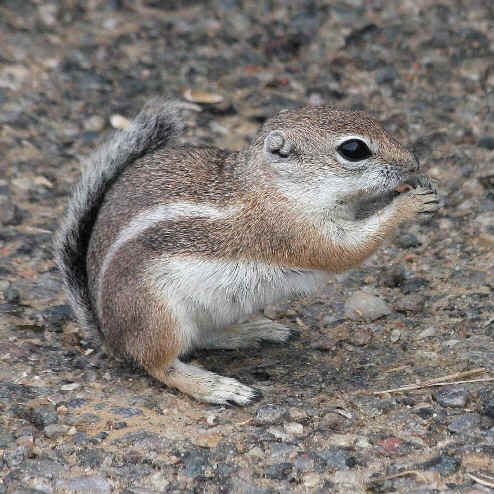
White-tailed Antelope Squirrel
(photo by Doris Potter)
- Nelson's Antelope Squirrel (t2)
______ (in the San Joaquin valley of southern California)
Ammospermophilus nelsoni
- California Ground Squirrel (ph) (*) ______
CA
Spermophilus
(formerly Otospermophilus) beecheyi

A California Ground Squirrel at Monterey, California
(photo by Armas Hill)
- Arctic Ground Squirrel (ph) (*) ______
AK
Spermophilus
(formerly Urocitellus) parryii

Arctic Ground Squirrel
(photo by Howard Eskin)
- Columbian Ground Squirrel ______
Spermophilus
(formerly Urocitellus) columbianus
- Spotted Ground Squirrel ______
AZ TX
Spermophilus
(formerly Ictidomys) spilosoma
- Thirteen-lined Ground Squirrel (*) ______
CO NE WY TX
Spermophilus
(formerly Ictidomys) tridecemlineatus
- Mexican Ground Squirrel (*) ______ NM
TX
Spermophilus
(formerly Ictidomys) mexicanus
- Richardson's Ground Squirrel ______
Spermophilus richardsonii
- Wyoming Ground Squirrel (*) ______ CO
WY
Spermophilus elegans
The Wyoming Ground Squirrel was conspecific with the Richardson's
Ground Squirrel (above).
- Washington Ground Squirrel (*) ______
WA
Spermophilus washingtoni
- Belding's Ground Squirrel (*) ______ WA
(seen in eastern Washington State,
slightly north of boundary in range maps)
Spermophilus beldingi
- Uinta Ground Squirrel ______
Spermophilus armatus
- Idaho Ground Squirrel ______
Spermophilus brunneus
- Merriam's Ground Squirrel ______
Spermophilus canus
- Piute Ground Squirrel ______
Spermophilus mollis
- Golden-mantled Ground Squirrel (*) ______
AZ CO
Spermophilus
(formerly Callospermophilus or Citellus) lateralis
- Cascade Golden-mantled Ground Squirrel
(*) ______ WA
Spermophilus
(formerly Callospermophilus) saturatus
The Cascade Golden-mantled Ground Squirrel is a recent
"split" from the Golden-mantled Ground Squirrel (above).
- Townsend's Ground Squirrel (*) ______
WA
Spermophilus townsendii
- Round-tailed Ground Squirrel (ph) (*)
______ AZ
Spermophilus
(formerly Xerospermophilus) tereticaudus

Round-tailed Ground Squirrel, photographed
during a FONT tour
- Mojave Ground Squirrel ______
Spermophilus
(formerly Xerospermophilus) mohavensis
- Variegated Ground Squirrel (or Rock
Squirrel) (ph) (*) ______ AZ
CO NM TX
Spermophilus
(formerly Otospermophilus) variegatus
- Franklin's Ground Squirrel ______
Spermophilus
(formerly Poliocitellus) franklinii
- Townsend's Chipmunk (*) ______ WA
Tamias
(formerly Neotamias) townsendii
- Yellow-pine Chipmunk (*) ______
WA
Tamias
(formerly Neotamias) amoenus
- Merriam's Chipmunk (*) ______ CA
Tamias
(formerly Neotamias) merriami
- Least Chipmunk (*) ______
AZ CO WA WY
Tamias
(formerly Neotamias) minimus
- Panamint Chipmunk (*) ______ CA
Tamias
(formerly Neotamias) panamintinus
- Colorado Chipmunk (*) ______ CO
Tamias
(formerly Neotamias) quadrivittatus
- Cliff Chipmunk (ph) (*) ______ AZ
Tamias
(formerly Neotamias) dorsalis

Cliff Chipmunk, photographed during a FONT
tour
- Alpine Chipmunk ______ (in high
altitude rocky alpine meadows in the Sierra Nevada range in California)
Tamias
(formerly Neotamias) alpinus
- Gray-footed Chipmunk ______ TX
(on
rocky, brushy slopes of south-central New Mexico & extreme west Texas)
Tamias
(formerly Neotamias) canipes
- California Chipmunk ______
Tamias
(formerly Neotamias) obscurus
- Yellow-cheeked Chipmunk ______
Tamias
(formerly Neotamias) ochrogenys
- Palmer's Chipmunk ______ (in
the Spring Mountains of southern Nevada)
Tamias
(formerly Neotamias) palmeri
- Long-eared Chipmunk ______
Tamias
(formerly Neotamias) quadrimaculatus
- Red-tailed Chipmunk ______
Tamias
(formerly Neotamias) ruficaudus)
- Hopi Chipmunk (ph) ______
Tamias
(formerly Neotamias) rufus

Hopi Chipmunk
(photo by Doris Potter)
- Shadow Chipmunk ______
Tamias
(formerly Neotamias) senax
- Siskiyou Chipmunk ______
Tamias
(formerly Neotamias) siskiyou
- Sonoma Chipmunk ______
Tamias
(formerly Neotamias) sonomae
- Lodgepole Chipmunk ______
Tamias
(formerly Neotamias) speciosus
- Uinta Chipmunk (*) ______
AZ
Tamias
(formerly Neotamias) umbrinus
- Eastern Chipmunk (ph) (*) ______
DE
Tamias striatus
The Eastern Chipmunk lives in hardwood forests among
logs and stumps. It is solitary and feeds on seeds, bulbs, fruits, nuts,
insects, and eggs. It runs with its tail straight up.

Eastern Chipmunk
(photo by Doris Potter)
- Eastern Gray Squirrel (i/wNA) (ph) (*) ______
BC DE NC NE TX
WA
Sciurus carolinensis
The Eastern Gray Squirrel inhabits
woodlands including those of oak and hickory. It is arboreal, rarely
venturing far from trees. It stores nuts and acorns in small holes, some of
which germinate and grow into trees.

Eastern Gray Squirrel
(photo by Doris
Potter)
- Western Gray Squirrel (*) ______
CA WA
Sciurus
(formerly Hesperosciurus) griseus
- Arizona Gray Squirrel (*) ______
AZ
Sciurus arizonensis
- Eastern Fox Squirrel (ph) (*) ______
CO NC NE TX VA
Sciurus niger
(northern form in Colorado & Nebraska; in Nebraska the black morph)
(in North Carolina, a dark southeastern form, but with white nose and
ears)

An Eastern Fox Squirrel photographed during the
FONT birding & nature tour
in North Carolina in May 2009
- Mexican Fox Squirrel (*) ______
AZ
Sciurus nayaritensis
The Mexican Fox Squirrel has been called the Apache
Fox Squirrel, Sciurus apache.
In the US, Sciurus
nayaritensis occurs only in the Chiricahua Mountains
in southeastern Arizona.
- Tassel-eared Squirrel (*)
______ AZ CO
Sciurus
(formerly Otosciurus) aberti
Another name for Sciurus aberti is the Abert's Squirrel.
One of the subspecies of the Tassel-eared Squirrel,
Sciurus aberti kaibabensis, is the "Kaibab
Squirrel".
- American Red Squirrel (*) ______
AK AZ CO NF WA
Tamiasciurus hudsonicus
Another name for Tamiasciurus
hudsonicus has been the "Spruce Squirrel".
- Douglas' Squirrel (*) ______ WA
Tamiasciurus douglasii
The Douglas' Squirrel is also
called the "Chickaree". Note, however, that the Red
Squirrel (above) is also referred to as the "Chickaree"
in the Rocky Mountains.
- Southern Flying
Squirrel (*) ______ DE TX
Glaucomys volans
Where it occurs the Southern Flying Squirrel can be common, but it is
not often seen because it is totally nocturnal. It inhabits hollow trees,
emerging after dark. It glides from tree to tree on a flap of skin between
its front and hind legs. It feeds on seeds, nuts, and insects.
- Northern Flying
Squirrel ______ AK
Glaucomys sabrinus
AQUATIC RODENTS
- American Beaver (ph) (*) ______
AK AZ CO DE NE NF WY
Castor canadensis
The American Beaver is a nocturnal animal, occasionally seen during
the day. It feeds on tree bark, and uses felled trees to build dams and
lodges.

American Beaver
(photo by Doris Potter)
- Muskrat (ph) (*) ______ AK
AZ
CO DE NE WA WY
Ondatra zibethicus
(the single member of its genus)
The Muskrat can be common in
various freshwater habitats, and it sometimes occurs in salt marshes. Its
houses can be seen as mounds of reeds and grasses rising above water
level.
The Muskrat has a tail that is flattened side to side. The animal is
trapped for its pelt.

Muskrat
(photo by Doris Potter)
- Nutria (or Coypu)
(i) (ph) (*) ______
NC TX WA
Myocastor coypus (the single member of its genus)
The Nutria is native to South America.

A Nutria, or Coypu, photographed during a FONT tour
(photo by Marie Gardner)
- Round-tailed
Muskrat ______
Neofiber alleni
(the single member of its genus)
POCKET
GOPHERS (Family Geomyidae)
- Northern Pocket Gopher ______
Thomomys talpoides
- Western Pocket Gopher ______
Thomomys mazama
- Camas Pocket Gopher ______
Thomomys bulbivorus
- Idaho Pocket Gopher ______
Thomomys idahoensis
- Wyoming Pocket Gopher ______
Thomomys clusius
- Townsend's Pocket Gopher ______
Thomomys townsendii
- Mountain Pocket Gopher ______
Thomomys monticola
- Botta's Pocket Gopher ______ TX
Thomomys bottae
- Southern Pocket Gopher ______
Thomomys umbrinus
- Yellow-faced Pocket Gopher (*) ______
TX
Pappogeomys
(formerly Cratogeomys)
castanops
- Plains Pocket Gopher ______ TX
Geomys bursarius
- Baird's Pocket Gopher ______ TX
Geomys breviceps
- Attwater's Pocket Gopher ______
TX (endemic to Texas)
Geomys attwateri
- Knox Jones' Pocket Gopher
______ TX
Geomys knoxjonesi
- Central Texas (or Llano) Pocket
Gopher ______ TX (endemic to Texas)
Geomys texensis
- Desert Pocket Gopher ______ TX
Geomys arenarius
- Texas Pocket Gopher ______ TX(south)
Geomys
personatus
- Southeastern Pocket Gopher ______
Geomys pinetis
MICE & RATS
- Woodland Jumping Mouse ______
Napacozapus insignis
- Meadow Jumping Mouse ______ AK
Zapus hudsonius
- Western Jumping Mouse ______
Zapus princeps
- Pacific Jumping Mouse ______
Zapus trinotatus
- North American Deermouse (*) ______
AK AZ WA
Peromyscus maniculatus
- White-footed Deermouse
______ AZ NC
Peromyscus leucopus
- Cotton Deermouse
______ NC
Peromyscus gossypinus
- Oldfield Deermouse
______
Peromyscus polionotus
- Northwestern Deermouse (*) ______
AK WA
Peromyscus keeni
- California Deermouse
______ CA
Peromyscus californicus
- Canyon Deermouse
______ AZ(Grand Canyon)
Peromyscus crinitus
- Cactus Deermouse
______ AZ
Peromyscus eremicus
- Merriam's Deermouse
______ AZ
Peromyscus merriami
- Pinon Deermouse
______ AZ
Peromyscus truei
- Northern Rock Deermouse
______ AZ
Peromyscus nasutus
- Saxicolous Deermouse
______
Peromyscus gratus
- Texas Deermouse
______
Peromyscus attwateri
- Brush Deermouse
______ AZ
Peromyscus boylii
- White-ankled Deermouse
______ TX
Peromyscus pectoralis
- Florida Deermouse
______ FL
Podomys floridanus
- Golden Mouse
______ FL
Ochrotomys nuttalli
- Chihuahan Pocket Mouse (*) ______
TX
Chaetodipus eremicus
- Olive-backed Pocket
Mouse (*) ______ CO
Perognathus fasciatus
- White-eared Pocket Mouse ______
CA (endemic to California)
Perognathus alticolus
- San Joaquin Pocket Mouse ______
CA (endemic to California)
Perognathus inornatus
- Arizona Pocket Mouse ______ AZ
Perognathus amplus
- Little Pocket Mouse ______
AZ CA
Perognathus longimembris
- Olive-backed Pocket Mouse ______CO
Perognathus fasciatus
- Plains Pocket Mouse (*) ______
CO KS TX
Perognathus flavescens
- Merrriam's Pocket
Mouse ______ TX
Perognathus merriami
- Silky Pocket Mouse
______ AZ CO TX
Perognathus fluvus
- Great Basin Pocket
Mouse ______ AZ(Grand Canyon)
Perognathus parvus
- California Pocket
Mouse ______ CA (endemic to California)
Chaetodipus californicus
- San Diego Pocket
Mouse ______ CA
Chaetodipus fallax
- Spiny Pocket Mouse
______ CA
Chaetodipus spinatus
- Nelson's Pocket
Mouse ______ TX
Chaetodipus nelsoni
- Rock Pocket Mouse
______ AZ TX
Chaetodipus intermedius
- Desert Pocket
Mouse ______ AZ CA
Chaetodipus penicillatus
- Bailey's Pocket
Mouse (*) ______ CA AZ
Chaetodipus baileyi
- Long-tailed Pocket
Mouse ______ AZ(Grand Canyon)
Chaetodipus formosus
- Hispid Pocket
Mouse ______ AZ CO NE TX
Chaetodipus hispidus
- Chihuahan Pocket
Mouse ______ TX
Chaetodipus eremicus
- Mexican Spiny Pocket
Mouse ______ TX
Liomys irroratus
- Northern Grasshopper
Mouse ______ AZ CO TX
Onychomys leucogaster
- Southern Grasshopper
Mouse ______ AZ TX
Onychomys torridus
- Chihuahuan Grasshopper
Mouse ______ TX
Onychomys arenicola
- Northern Pygmy
Mouse ______ AZ TX
Baiomys taylori
- Fulvous Harvest
Mouse ______ AZ TX
Reithrodontomys fulvescens
- Eastern Harvest
Mouse ______ NC TX
Reithrodontomys humulis
- Plains Harvest Mouse (*) ______
AZ CO
KS NE
Reithrodontomys montanus
- Western Harvest
Mouse ______ AZ CA WA
Reithrodontomys megalotis
- Saltmarsh Harvest
Mouse (t2) ______ CA (endemic to California)
Reithrodontomys raviventris
- Eastern Woodrat ______ TX
Neotoma floridana
- Allegheny Woodrat ______
Neotoma magister
- Bushy-tailed Woodrat ______ AK
AZ
Neotoma cinerea
- Mexican Woodrat ______ AZ
TX
Neotoma mexicana
- Arizona Woodrat ______ AZ
Neotoma devia
- White-throated Woodrat (*) ______
AZ TX
Neotoma albigula
- Stephen's Woodrat
______ AZ
Neotoma stephensi
- Southern Plains Woodrat
______ TX
Neotoma micropus
- Desert Woodrat
______ AZ CA
Neotoma lepida
- Dusky-footed Woodrat
______ CA
Neotoma fuscipes
Rice Rats in the genus ORYZOMYS (below),
are nocturnal, mostly aquatic rats that are diverse in the Neotropics where
there are than 35 species.
- Marsh Rice Rat
______ NC TX
Oryzomys palustris
- Silver Rice Rat
______ FL
Oryzomys argentatus
- Coues' Rice
Rat ______ TX(far-south)
Oryzomys couesi
- Hispid Cotton Rat (*) ______
AZ NC TX
Sigmodon hispidus
- Yellow-nosed Cotton
Rat ______ AZ
Sigmodon ochrognathus
- Arizona Cotton Rat
______ AZ
Sigmodon arizonae
- Tawny-bellied Cotton
Rat ______ AZ
Sigmodon fulviventer
- Red Tree Vole
______
Arborimus longicaudus
- Sonoma Tree Vole
______ CA
Arborimus poma
- White-footed Vole
______
Arborimus albipes
- Northern Red-backed
Vole ______ AK
Clethrionomys rutilus
- Southern Red-backed
Vole ______ AK
Clethrionomys gapperi
- Western Red-backed
Vole ______
Clethrionomys californicus
- Meadow Vole (ph) (*) ______
AK DE
Microtus pennsylvanicus
The Meadow Vole can be abundant
in grassy, upland fields. It also occurs among the grasses of a salt marsh.
It is a good swimmer.
It feeds on grasses, sedges, seeds, and grain. The animal if fed upon by
various raptors, among them the Northern Harrier.

Meadow Vole
(photo by Doris Potter)
- Woodland Vole ______
Microtus pinetorum
- Rock Vole ______
Microtus chrotorrhinus
- Singing Vole (*) ______ AK
Microtus
(formerly
Stenocranius)
miurus
Microtus miurus
has been called the Alaska Vole.
- Insular Vole ______ AK
Microtus abbreviatus
Microtus abbreviatus is also called the St. Matthew Island Vole.
- Tiaga Vole (*) ______
AK
Microtus (formerly
Aulacomys) xanthognathus
Microtus xanthognathus
has been called the Yellow-cheeked Vole.
- Tundra Vole ______ AK
Microtus occonomus
- Long-tailed Vole ______ AK
AZ WA
Microtus longicaudus
- Montane Vole ______ WA
Microtus montanus
- Townsend's Vole ______ WA
Microtus townsendii
- Creeping Vole ______ WA
Microtus oregoni
- Montane Vole ______ WA
Microtus montanus
- Water Vole ______ WA
Microtus richardsoni
- Sagebrush Vole ______ WA
Microtus curtatus
- California Vole ______ CA
Microtus californicus
- Gray-tailed Vole ______
Microtus canicaudus
- Mogollon Vole ______ AZ
Microtus mogollonensis
- Prairie Vole ______
Microtus ochrogaster
- Beach Vole ______
Microtus breweri
- Eastern Heather Vole ______
Phenacomys ungava
- Western Heather Vole ______ AK
Phenacomys intermedius
The first Western Heather Vole specimen in Alaska was
identified in 1999.
- Northern Bog Lemming
______ AK
Synaptomys borealis
- Southern Bog Lemming ______
Synaptomys cooperi
- North American Brown Lemming ______
AK
Lemmus trimucronatus
- Northern Collared Lemming ______
AK
Dicrostonyx groenlandicus
- Ungava Collared Lemming ______
Dicrostonyx hudsonicus
- Richardson's Collared Lemming ______
Dicrostonyx richardsoni
- House Mouse (i) ______ AK
AZ
Mus musculus
- House Rat (i) ______ TX
Rattus rattus
- Brown Rat (i) ______ AK
TX
Rattus norvegicus
Rattus norvegicus is also called the Norway Rat. It is
introduced worldwide with human settlements, originally from southeast
Siberia & northern China.
NEW WORLD PORCUPINES (Family Erethizontidae)
- North American Porcupine (ph) (*) ______
AK AZ CO TX WA
Erethizon dorsatum

North American Porcupine
(photo by Doris Potter)
CARNIVORES (Order Carnivora)
Families include:
Canines: Dogs & Foxes (Canidae)
Felines: Cats (Felidae)
Bears: (Ursidae)
Procyonids: Raccoons & allies (Procyonidae)
Mustelids: Weasels, Skunks & allies (Mustelidae)
CANINES:
- Coyote (ph) (*) ______ AK
AZ CA CO KS NE TX
WA
(See notes below under the Eastern Wolf)
Canis latrans

Above: A Coyote
Below: An applicable comment regarding the widespread & adaptable
Coyote.
(upper photo by Marie Gardner; lower photo by Doris Potter)

- Gray Wolf ______ AK
Canis lupus
- Red Wolf (t1) (*) ______ NC(i)
Canis rufus
Some contend the Red Wolf to be a "historical hybrid" between
the Gray Wolf, Canis lupus, and the
Coyote, Canis
latrans.
The
"Red
Wolf"
was introduced into eastern North Carolina from the Southwest US.
- Eastern Wolf ______
Canis lycaon
The Eastern Wolf is said to be a distinct species,
although it has also been said to be a subspecies of the Gray Wolf or
the Red Wolf. Science has shown that it is closely related to them,
but that is not the same species as either of them.
The Eastern Wolf is a small to medium sized wolf with a light brown
or reddish coat. They also have some longer hairs in their coat that are
usually black. As Eastern Wolves gets older, they develop more of
those long black hairs.
Eastern Wolves are often mistaken for Coyotes due to their
coloring and build.
Well known are the Eastern Wolves in the area of the Algonquin
Provincial Park in Ontario, Canada. They have a large home range. It is
believed that packs of Eastern Wolves follow the movements of White-tailed
Deer, as a way to have plenty to eat, especially in the winter
months.
Eastern Wolves are said to be very dependent upon the social aspects
of their pack. They are quite loyal to each other and will do all they can
to keep other packs of wolves out of their territory. That is why they are
often heard howling, so as to publicize and protect their
territories.
Eastern Wolves are most active at night but they can also be seen out
during the day.
The Eastern Wolf has a diverse diet. Sometimes animals hunt on their
own, but most of the time they hunt with their pack. Some of their prey when
they hunt alone include rodents, beaver, and muskrat. Prey
when they hunt in their pack includes deer and moose. In some
instances, they have even been able to successfully kill a Black Bear.
The alpha and beta animals mate in February, with the young
born about two months later.
The Eastern Wolf has been known to mate with different types of Coyotes
in their areas. That can definitely affect the overall genetics of the
species (see below the results of a recent study).
It is interesting
behavior because otherwise wolves have often been known to aggressively run
off Coyotes, and in the case of the Gray Wolf in the west,
even kill
them.
In a recent genetic study, published in May 2011, and adding fuel to a
longstanding debate, it was determined that wolves in the eastern
United States are hybrids of Gray Wolves and Coyotes,
while Coyotes in that region are actually wolf-coyote-dog hybrids.
There were 16 researchers involved in the study from around the globe. It
was said to be the most detailed genetic study of any wild vertebrate
species to date.
The study is not likely to have any impact on the management of the endangered
Red Wolf in North Carolina and the Eastern Wolf in Ontario,
but it offers some fresh insight into their genetic make-up and concludes
that those wolves are hybrids that developed over the last few hundred
years.
On the other hand, some scientists have argued that the Red
Wolf, Canis rufus, and the Eastern Wolf, Canis
lycaon, evolved from an ancient wolf species distinct from
the larger Gray Wolf, Canis lupus, of western North America.
The recent study, referred to above, showed a gradient of hybridization
in wolves, as follows:
In western North America, wolves were pure wolf.
In the western Great Lakes region, they averaged 85 percent wolf and 15
percent Coyote.
Wolves in Algonquin Park in eastern Ontario averaged 58 percent wolf.
The Red Wolf in North Carolina, which as been the subject of
extensive preservation and restoration efforts, was found to be 24
percent wolf and 75 percent coyote.
Coyotes, in the northeastern US, which only colonized in the region
in the past 60 years, were found to be 82 percent coyote, 9
percent dog, and 9 percent wolf.
In a study, last year, museum specimens and genetic samples were used to
show that Coyotes migrating eastward bred with wolves to
evolve into a larger form that has become the top predator in the Northeast
US, filling a niche left when native eastern wolves were hunted out
of existence. This hybridization allowed Coyotes to evolve from the
smaller mouse-eater of western grasslands to a larger deer-hunter in
eastern forest.
Still a question is how it is that Gray Wolves don't typically breed
with Coyotes, but kill them. In the West, wolves don't
hybridize with Coyotes, even in the circumstance when single wolves
looking for mates have dispersed into the middle of "Coyote
country".
For A TOUR INCLUDING AN AREA WITH
WOLVES in conjunction with the Timber Wolf Alliance

Eastern Wolf
- Gray Fox (*) ______
AZ CA CO TX WA
Urocyon cinereoargenteus
(would be monotypic were it not for the
Island Gray Fox
of the Channel Is. of California, Urocyon littoralis)
- Island Gray Fox ______ CA
(restricted to 6 Channel Islands off the California coast; half to
two-thirds the size of the Gray Fox)
Urocyon littoralis
- Red Fox (ph) (*) _____
AK AZ CA CO NE WA
Vulpes vulpes fulva
(the North
American animal considered now to be conspecific with the Old World Red Fox, Vulpes
v. vulpes)
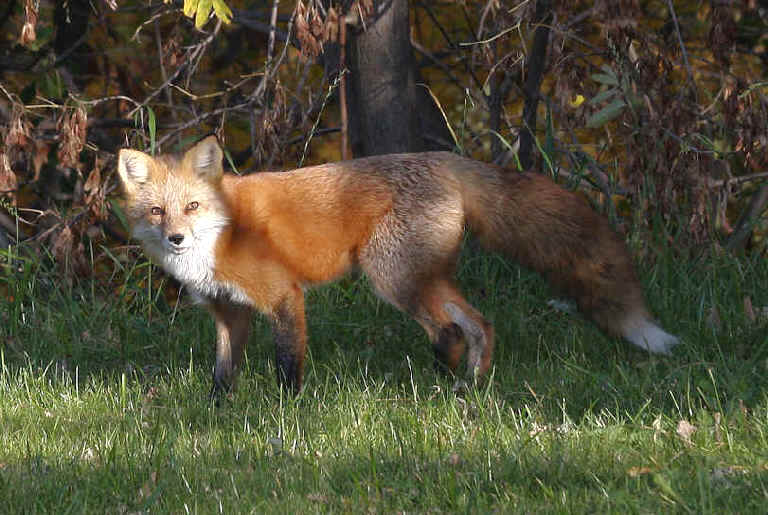
Red Fox
(photo by Doris Potter)
- Swift Fox (*) ______ CO
Vulpes velox
- Kit Fox (*) ______ AZ
TX
Vulpes macrotis
- Arctic Fox (*) ______
AK
Vulpes
(formerly Alopex) lagopus
FELINES:
- Bobcat (ph) (*) ______ AZ
CA NC TX
Felis
(formerly Lynx) rufa

A Bobcat photographed
during a FONT tour in Arizona in August 2010
(photo by Marie Gardner)
- Canadian Lynx
______ AK
Felis
(formerly Lynx) canadensis
- Puma (ph) ______ AK
AZ
Felis
(formerly Puma) concolor
Other names for the Puma
include Mountain Lion and Cougar.
- Ocelot (ph) ______ AZ(very
rare)
Felis
(formerly Leopardus) pardalis
- Jaguarundi ______ AZ(rare)
Felis
(formerly Herpailurus) yagouaroundi
- Jaguar (nt) (ph) ______
AZ(very rare)
Panthera
(formerly Jaguarius) onca
Jaguars, during recent years, have
occurred in southern Arizona. None were recorded there from 1938 until
1987, when one was killed in the Dos Cabezas Mountains.
Another was photographed in the Peloncillo Mountains in 1996.

A Painting of a Jaguar by a person in southern Arizona, Bonnie Swarbrick
BEARS:
- American Black Bear (*) ______
AK AZ NC
Urus (formerly Euarctos) americanus
(Up to 18 subspecies are recognized.)
Not all "Black
Bears" are black. Some coastal populations of British Columbia
and Alaska are creamy white, the "Kermode Bear".
Others are bluish gray, the "Glacier Bear". Another
population in the Northwest US is light reddish-brown, the "Cinnamon
Bear". Most in the eastern US are black.

American Black Bear
(photo by Peter Burke)
- Brown Bear (*) ______
AK
(also called Grizzly Bear)
Ursus arctos (has also been Ursus horribilis)
The larger "Big
Brown (or Kodiak) Bear" of Alaska
& northwest Canada has been considered a distinct species, U.
middendorffi, but generally it is now considered conspecific with
U.
arctos.
The Brown Bear of North America, Europe, and Asia is now by
most considered as a single species.

A Grizzly Bear in Alaska
(photo by Howard Eskin)
- Polar Bear (t3) ______ AK
Thalarctos maritimus (the single member of its genus)
PROCYONIDS:
- Northern Raccoon (ph) (*) ______
AK(i) AZ CO DE FL NC
NE TX VA WA
Procyon lotor

Northern Raccoon
(photo by Doris
Potter)
- Ringtail (*) ______ AZ TX
Bassariscus astutus
- White-nosed Coati (ph) (*) ______
AZ
Nasua narica

White-nosed Coati
(photo by Marie Gardner)
AQUATIC MUSTELIDS
- American Mink (ph) (*) ______
AK DE NC
Mustela vison
There formerly was a "Sea Mink", larger and redder, Mustela
v. macrodon, along the North Atlantic coast. It was trapped to extinction by
the 1860's. Some say it was a full species.
Other species in the Mustela genus follow in "Other Mustelids".

American Mink
(photo by Howard Eskin)
- Northern River Otter (*) ______
AK AZ CA NC WA
Lutra
(formerly Lontra) canadensis
The Northern River Otter is up to 5 feet in length; up to 22 pounds in
weight.
- Sea Otter (t2) (ph) (*) ______ AK
CA
Enhydra lutris
(the single member of its genus)

Sea Otters
OTHER MUSTELIDS:
- American Badger (ph) (*) ______
AZ CO
Taxidea taxus (the single member of its genus)

An American Badger
photographed during a FONT Colorado tour
- Eastern Spotted Skunk ______
Spilogale putorius
- Western Spotted Skunk (*) ______
AZ CO
Spilogale gracilis
- Hooded Skunk (*) ______ AZ
Mephitis macroura
- Striped Skunk (ph) (*) ______
AZ CO NE TX
Mephitis mephitis

Striped Skunk
(photo by Howard Eskin)
- Eastern Hog-nosed
Skunk ______
Conepatus leuconotus
- Western Hog-nosed
Skunk ______ AZ
Conepatus mesoleucus
- American Marten
______ AK
Martes americana
- Fisher ______
Martes pennanti
- Ermine
______ AK AZ
Mustela erminea
Other names for Mustela erminea
are Short-tailed Weasel and Stout.
- Long-tailed Weasel
______ AZ
Mustela frenata
- Least Weasel
______ AK
Mustela nivalis
- Black-footed
Ferret (t1) ______ AZ(formerly)
Mustela nigripes
- Wolverine ______ AK CO
Gulo gulo (the single member of its genus)
A lone Wolverine that arrived in Colorado in early June 2011 was the
first confirmed in Colorado since 1919.
Late the previous year, in December of 2010, and further north, biologists
outfitted with a tracking collar a young Wolverine, as part of a
reintroduction program.
That animal made a 500-mile journey from where it had been caught in the
Grand Teton National Park in Wyoming.
It was tracked as it crossed rugged terrain and some busy highways in
Wyoming, from the Togwotee Pass to the Wind River Range and across sagebrush
areas. The lone animal traveled until it crossed into Colorado on
June 1.
The Wolverine reintroduction program, referred to here, began in
2001.
Most Wolverines live in Alaska and Canada. But formerly
the animal did range in Idaho, Montana, Wyoming, Utah, Colorado, California,
and Washington State.
The Wolverine is one of the most elusive of mammals, a
mysterious creature. It is known as being fearless and aggressive. It is
strong, tenacious, sharp-toothed, and cunning.
Although adult Wolverines typically weigh about 30 pounds, they are
stocky and "bear-like", and they prey on animals larger than they
are. Even though the Wolverine is not a big animal, it is the largest
land-dwelling member of the weasel family.
Wolverines have evolved to require huge territories for roaming. A
male's territory might be as much as 500 square miles, and he might share
that landscape with 2 or 3 females that breed every other year, and usually
produce a litter of two. Thus the species has a slow reproduction rate.
Although a good survivor in nature, the Wolverine could not survive
the trappers who prized its almost waterproof fur, and the ranchers who
killed it with poison bait. So the animal pretty much vanished from the
lower 48 states about a century ago.
The Wolverine in Colorado in 2011 was the first known to be in
the state in 90 years. And, thus far, the only one.
SHREWS & MOLES in the Order Insectivores "insect eaters" -
this
group, throughout much of the world, includes shrews, moles, hedgehogs,
moonrats,
and tenrecs. (Family Soricidae)
- Cinereous Shrew ______ AK
Sorex cinereus
- Southeastern Shrew (ph) ______
DE
Sorex longirostris
Sorex longirostris
has been conspecific with the Cinereous Shrew, Sorex
cinereus, and when so it was known as the Masked Shrew.
The Southeastern Shrew inhabits a variety of land habitats, but it is
less common in upland tracts. It is subterranean, and seldom seen alive.
It hunts for insects and other small animals day or night, and eats more
than its own body weight each day.

Not alive was this Sorex longirostris found in coastal Delaware,
photographed in 1998. With it, is a US cent.
(photo by Alan Brady)
- American Pygmy Shrew ______ AK
Nicrosorex
(formerly Sorex) hoyi
The American Pygmy Shrew is the smallest mammal in North America.
- Alaska Tiny Shrew ______
AK (endemic to Alaska)
Sorex yukonicus
The Alaska Tiny Shrew was described in 1997.
- American Long-tailed Shrew ______
Sorex dispar
- Smoky Shrew ______
Sorex fumeus
- Gaspe Shrew ______ (rocky areas
of Gaspe Peninsula in Quebec & Cape Breton Island, Nova Scotia)
Sorex gaspensis
- American Water Shrew ______ AK
Sorex palustris
- Glacier Bay Water Shrew ______
AK (endemic to Alaska)
Sorex alaskanus
- Marsh Shrew ______
Sorex bendirii
- Arctic Shrew ______
Sorex arcticus
- Maritime Shrew ______
Sorex maritimensis
The Maritime Shrew was split from the Arctic Shrew in
2002.
- Tundra Shrew ______ AK
Sorex tundrensis
- Prairie Shrew ______
Sorex haydeni
- American Dwarf Shrew ______ AZ
Sorex nauus
- Merriam's Shrew ______ AZ
Sorex merriami
- Arizona Shrew ______ AZ
Sorex arizonae
- Preble's Shrew ______
Sorex preblei
- Mount Lyell Shrew ______
Sorex lyelli
- Inyo Shrew ______
Sorex tenellus
- Ornate Shrew ______
Sorex ornatus
- Baird's Shrew ______
Sorex bairdii
- Fog Shrew ______
Sorex sonomae
- Vagrant Shrew ______ AZ
Sorex vagrans
- Pacific Shrew ______
Sorex pacificus
- Trowbridge's Shrew ______
Sorex trowbridgii
- Montane (formerly Dusky)
Shrew (*) ______ AK WA
Sorex monticolus
- Barren Ground Shrew ______ AK
Sorex ugyunak
- Pribilof Island Shrew (t2) (*) ______
AK
(endemic to the Pribilof Islands)
Sorex pribilofensis (name
changed in 1997 from
Sorex hydrodromus)
- Least Shrew ______ DE
Cryptotis parva
The Least Shrew is found in open, grassy areas and marshes. It is
distinguished from other shrews by its cinnamon color and short tail. It
eats insects and other small animals.
- Northern Short-tailed
Shrew ______ DE
Blarina brevicauda
The Northern Short-tailed Shrew is
most abundant in damp woods with thick leaf mold. It feeds on insects,
worms, snails, and other invertebrates. Its salvia is poisonous. It has no
external ears.
- Southern Short-tailed
Shrew ______
Blarina carolinensis
- Eliot's Short-tailed
Shrew ______
Blarina hylophaga
- Desert Shrew
______
Notiosorex crawfordi
- Cockrum's Desert
Shrew ______
Notiosorex cockrumi
- American Shrew
Mole ______
Neurotrichus gibbsii (the single member of its genus)
- Townsend's Mole
______
Scapanus townsendii
- Broad-footed Mole
______
Scapanus latimanus
- Coast Mole ______
Scapanus orarius
- Eastern Mole
______ DE
Scalopus aquaticus
(the single member of its genus)
The Eastern Mole inhabits moist, upland
soils where it tunnels its way under the surface. It is active day or night
in burrows where it eats worms, insects, and some vegetable matter. It has a
naked tail, no external ears, and eyes covered with thin skin.
- Hairy-tailed Mole
______
Parascalops breweri
(the single member of its genus)
- Star-nosed Mole
______ DE
Condylura cristata (the single member of its genus)
Condylura
cristata is the only North
American mammal with a nose surrounded by finger-like, fleshy projections
giving the appearance of a star.
The Star-nosed Mole prefers low, wet ground where it burrows for
insects, many of them aquatic. It often appears above ground.
BATS (Order Chiroptera -
with about 950 species worldwide, the
diversity of bats is second only to that of
rodents)
White-nose
Syndrome has recently been a deadly
disease in North America bats, especially the Little Brown Myotis.
The disease has been spreading rapidly since its discovery in 2006 in New
York State.
Thus far, bat declines in the northeastern US have exceeded 80 per cent.
Scientists with the U.S. Geological Survey and partner institutions have
identified the cause of White-nose Syndrome as a fungus appropriately
known as Geomyces destructans.
The research has further demonstrated that the fungus can be spread through
contact between individual bats during hibernation.
LEAF-CHINNED BAT (Family MORMOOPIDAE) (8 species in the New
World)
-
(Peter's) Ghost-faced Bat ______
Mormoops megalophylla
AMERICAN LEAF-NOSED BATS (Family PHYLLOSTOMIDAE) (155 species in
the New World)
- California Leaf-nosed
Bat ______ AZ
Macrotus californicus
- North American Long-nosed Bat (ph)
(*) ______ AZ
Leptonycteris yerbabuenae (formerly conspecific with
what's now the Mexican Long-nosed Bat, L.
nivalis)
The population of the North American Long-nosed Bat in Arizona was formerly considered by some a distinct
species, the Sanborn's Long-nosed Bat, L.
sanborni.
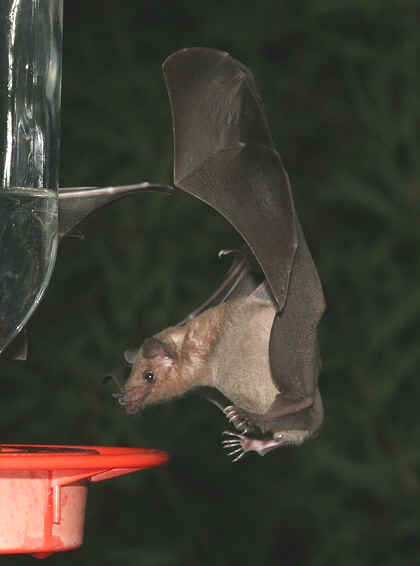
A North American Long-nosed Bat at a hummingbird
feeder after dark
- Mexican Long-nosed Bat (t2) ______
AZ
(summer migrant from Mexico into Texas)
Leptonycteris nivalis
- Mexican Long-tongued Bat (ph) (*) ______ AZ
Choeronycteris mexicana (the single member of its genus)

A Mexican Long-tongued Bat at a hummingbird
feeder after dark
- Hairy-legged Vampire Bat ______
Diphylla ecaudata
FREE-TAILED BATS (Family MOLOSSIDAE) (94 species worldwide)
- Mexican (or Brazilian) Free-tailed Bat
(ph)
(*) ______ AZ NM TX
Tadarida brasiliensis
There are many Mexican Free-tailed Bats at Carlsbad Caverns in
New Mexico.

ABOVE & BELOW:
Mexican Free-tailed Bats

- Big Free-tailed Bat (*) ______
AZ NM
Nyctinomops macrotis
- Pocketed Free-tailed
Bat ______ AZ
Nyctinomops femorosaccus
- Greater Bonneted
Bat ______ AZ
Eumops perotis
Eumops perotis
is also called the Western Mastiff Bat.
- Underwood's Bonneted
Bat ______ AZ
Eumops underwoodi
In the US, the Underwood's Bonneted Bat is known only in extreme
southern Arizona, where it can be found drinking at desert
pools.
- Wagner's Bonneted
Bat ______
Eumops glaucinus
- Pallas's Mastiff
Bat ______
Molossus molossus
VESPER BATS (Family VESPERTILIONIDAE) (364 species
worldwide)
- Silver-haired Bat (ph) (*) ______
AK AZ NJ (p)
Lasionycteris noctivagans (the single member of its genus)
A Silver-haired Bat came onboard a FONT pelagic trip, 70 miles offshore from
New Jersey, September 12, 2004.It is in the photo below.

Silver-haired Bat
- Eastern Red Bat (ph) (*) ______ NJ (p)
Lasiurus borealis
The Eastern Red Bat and the Western Red Bat (below)
have recently been "split".
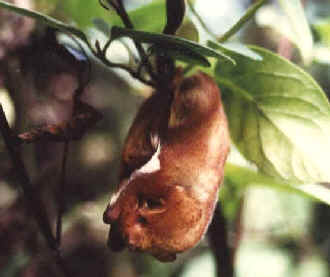
An Eastern Red Bat in a tree, during the day
(photo by Alan Brady)
- Western Red Bat ______ AZ
Lasiurus blossevillii
- Seminole Bat (*) ______ NC
Lasiurus seminolus
- Northern Yellow Bat ______
Lasiurus intermedius
- Southern Yellow Bat ______
Lasiurus egaq
- Western Yellow Bat ______ AZ
(was
part of the Southern Yellow Bat)
Lasiurus xanthinus
- Hoary Bat ______ AZ
Lasiurus cinereus
- Spotted Bat ______ AZ
Euderma maculatum
- Rafinesque's Big-eared Bat ______
Corynorhinus rafinesquii
- Townsend's Big-eared Bat ______
AZ
Corynorhinus townsendii
- Allen's
(or Mexican) Big-eared Bat ______ AZ
Idionycteris phyllotis
- Pallid Bat ______ AZ
Antrozous pallidus
- Southwestern Myotis ______ AZ
Myotis auriculus
- Fringed Myotis ______ AZ
Myotis thysanodes
- Long-eared Myotis ______
Myotis evotis
- Keen's Myotis ______
Myotis keenii
- Northern Myotis ______
Myotis septentrionalis
- California Myotis (*) ______
AZ CA
Myotis californicus
- Western Small-footed Myotis ______
AZ
Myotis ciliolabrum
- Eastern Small-footed Myotis ______
Myotis leibii
- Long-legged Myotis ______
Myotis volans
- Cave Myotis ______ AZ
Myotis velifer
- Yuma Myotis (*) ______ AZ
TX
Myotis
(formerly Leuconoe) yumanensis
- Little Brown Myotis (*) ______
AK AZ CO NC
Myotis
(formerly Leuconoe) lucifugus
- Gray Myotis ______
Myotis grisescens
- Southeastern Myotis ______
Myotis austroriparius
- Indiana Myotis ______
Myotis sodalis
- Big Brown Bat (ph) (*) ______
AZ CA WA
Eptesicus fuscus

A Big Brown Bat photographed in Delaware in January 2013
(photo by Marie
Gardner)
- Evening Bat ______
Nycticeius humeralis
- Eastern Pipistrelle (*) ______ NC
Pipistrellus (formerly Perimyotis)
subflavus
- Western Pipistrelle (*) ______ AZ
TX
Pipistrellus
(formerly
Hypsugo) hesperus
MARINE MAMMALS I - SEALS & SEA LIONS (Order Pinnidedia,
"fin-footed")
EARED SEALS, including SEA LIONS & FUR SEALS (Family Otariidae)
- California Sea Lion (ph) (*) ______ CA
Zalophus californiannus (the single member of its genus)
The Galapagos Sea Lion is a
race of Zalophus californiannus.
There is another rare subspecies in Japan.
Male California Sea Lions are about 6.5 feet in length, and
weigh up to almost 600 pounds; females about 5.9 feet in length, and
weighing up to 198 pounds.

California Sea Lion
(photo by Abram Fleishman)
- Northern
Sea Lion (nt) (*) ______ AK WA
Eumetopias jubatus
(the single member of its genus)
Eumetopias
jubatus has also been called the Steller's Sea Lion.
Male Northern, or Steller's. Sea Lions are nearly 10 feet long, and can weigh up to 2,200 pounds; females
up 6.6 feet in length, and weighing up to 660 pounds.
The smallest adult Steller's Sea Lion
is larger than the largest California Sea Lion.
- Northern Fur Seal (t3) (ph) (*) ______
AK CA WA
Callorbinnus ursinus (the single member of its genus)

A Northern Fur Seal,
photographed during a FONT Tour in Alaska
HAIR, including PHOCID, SEALS (Family Phocidae)
- Harbor Seal (ph) (*) ______ AK
CA DE WA VA
Phoca vitulina
The Harbor Seal ranges from 3.9 to 5.9 feet in length, weighs
from 99 to 230 pounds.
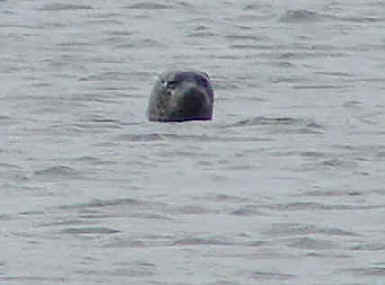
Harbor Seals
(above photo by James Scheib, during a FONT tour;
photo below by Howard Eskin)

- Ringed Seal (*) ______ AK
Pusa
(formerly Phoca) hispida
- Ribbon Seal (t3) ______
AK
Histnophoca
(formerly Phoca) fasciata (the
single member of its genus)
- Spotted Seal ______ AK
Phoca largha
- Harp Seal ______
Phoca groenlandica
- Hooded Seal ______
Cystophora cristata
- Gray Seal ______
Halichoerus grypus
- Bearded Seal (*) ______
AK
Erignathus barbatus (the single member of its
genus)
- Northern Elephant Seal (*) ______
AK CA
Mirounga angustirostris
Male Northern Elephant Seals can be over 16 feet in length,
and weigh up to 4,400 pounds; females weigh up to 1,760 pounds.
WALRUS (Family Odobenidae)
- Walrus (nt) (ph) (*) ______
AK
Odobenus rosmarus (the single member of its genus)

Two Walrus,
photographed in Alaska
(photo by Paul West)
EVEN-TOED UNGULATES (Order Artiodactyla)
(This order worldwide is diverse, including:
pigs, hippopotamuses, camels,
deer, antelope, and cattle.)
SHEEP, GOATS, BISON, & MUSKOX (Family Bovidae)
- Bighorn Sheep (ph) (*) ______
AZ CO WA
Ovis canadensis
(the "Rocky Mountain Bighorn Sheep" in Colorado, O. c. canadensis)
(the "Desert Bighorn Sheep" in Washington State)

A
Bighorn Sheep, Ovis canadensis, in the Rocky Mountains of
Colorado.
(photo by Rick Greenspun,
during a FONT tour in Colorado)
- Dall's Sheep (*) ______ AK
Orvis dalli

Above & below: Dall's, or White Sheep photographed in Alaska
in the area of the Denali National Park in June 2013
(photos by Mark Felber)

- Mountain Goat (*) ______ AK
Ocramnos americanus (the single member of
its genus)
- (Plains) American Bison (or Buffalo)
(ph) (*) ______ AK(i) CO (today domesticated)
Bison b. bison
Another subspecies, Bison bison
athabascae, is called the "Wood Bison".

An old photograph of American Bison when they still roamed freely in the
western US
- Muskox (*) ______ AK
Ovibus moschatus (the single member of
its genus)
The Muskox was nearly extinct at the end of the 19th
Century. It is now
re-established in parts of Alaska.
PRONGHORN ANTELOPE (Family Antilocapridae)
There is only one living species in this exclusively American family.
- Pronghorn (ph) (*) ______
AZ CO KS NE OK TX
WY
Antilocapra americana (the single member of its genus)
The Pronghorn is the fastest North American mammal. It has been clocked at 60
mph.

Pronghorn
NEW WORLD PIGS OR PECCARIES
-
2 species, 1 of which
north of Mexico (Family Tayassuidae)
The
Old World Swine (Boars,
introduced various places in North
America) are in the
Family Suidae.
- Collared Peccary (ph) (*) ______
AZ TX
Dicotyles (formerly Pecari) tajacu (was at one time Pecari angulatus)
Another name for the Collared Peccary is Javelina.

Collared Peccaries
DEER (Family Cervidae) Hoofed animals with antlers shed each year
- "American" Elk (ph)
(*) ______ AZ CO WA WY
Cervus elaphus canadensis
Another name for Cervus elaphus canadensis
has been the Wapiti.
Another, slightly smaller, subspecies of Cervus
elaphus in Europe is called there the Red Deer.

Above & below: Elk
(or Wapiti)
Above: a male; below: a female with a Magpie
(top photo by Doris Potter)

- "Tule" Elk (*) ______
CA
Cervus elaphus nannodes (a subspecies of the
Elk
in
California)
- Moose (ph) (*) ______ AK
CO
Alces alces (the single member of its genus)
What is called the Moose in North America is called the Elk in
Europe.
The subspecies of the Moose, Alces alces gigas
is the largest, with males weighing up to 1,600 pounds and females up to
1,300 pounds.

Moose, photographed during a FONT tour
- Mule Deer (ph) (*) ______
AZ CA CO KS NE
NM OK TX WA WY
Odocoileus hemionus
A subspecies, Odocoileus
hemionus columbianus, is called the Black-tailed
Deer.

Mule Deer
- White-tailed Deer (ph) (*) ______
AZ CO DE FL KS
NC NE TX WA
Odocoileus virginianus
(including "Columbian White-tailed Deer" in the Pacific Northwest)
(including "Coue's White-tailed Deer" in Arizona)
(including "Sierra del Carmen White-tailed Deer" in the Chisos
Mtns of west Texas)
(including "Key White-tailed Deer" in the Florida
Keys)
(This mammal occurs in all 48 states of the lower mainland US.)
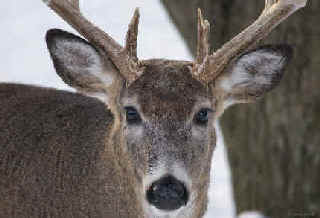
White-tailed Deer
(photo by Howard Eskin)
- (Common) Fallow Deer (i) (ph) (*) ______
CA
(feral at Point Reyes, CA; originally in the Mediterranean region of the Old
World)
Dama dama
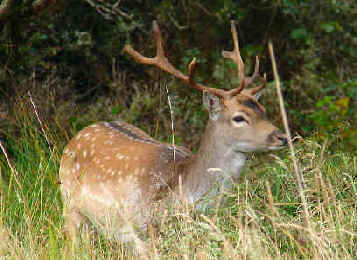
Fallow Deer
(photo by James Scheib)
- (Barren Ground) Caribou (*) ______
AK
Rangifer tarandus (the single member of
its genus)
- "Reindeer" (i) (ph) (*) ______
AK
(either from domesticated stock or from European Caribou)
Rangifer
tarandus
SIRENIANS (Order Sirenia)
MANATEES (Family Trichechidae)
There are 3 species of manatees in the world.
- West Indian Manatee (ph) (*) ______
FL (has also been called "Sea Cow")
Trichechus manatus
MARINE MAMMALS II - PORPOISES, DOLPHINS, & WHALES (Order Cetacea)
TOOTHED WHALES (Suborder Odontoceti) include:
Dolphins & Porpoises, the Beaked Whales, Sperm Whales, the
Beluga and
Narwhal.
OCEAN DOLPHINS (Family Delphinidae)
- Short-beaked Common Dolphin (ph) (*)
______ CA DE NJ
(p) (also called "Saddleback Dolphin")
Delphinus delphis
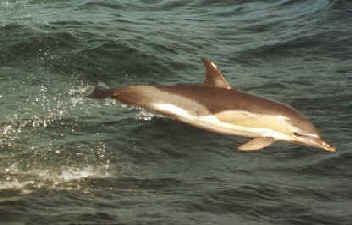
Short-beaked Common Dolphin, during a FONT tour
(photo by Andy Smith)
- Common Bottle-nosed Dolphin (ph)
inshore population (*) ______ DE
NC
offshore population (*) ______ DE NJ (p)
Tursiops truncatus
(in the Atlantic, called "Atlantic Bottlenose Dolphin")

An offshore Common Bottle-nosed Dolphin during a
FONT pelagic trip
off the East Coast of North America
- Atlantic Spotted Dolphin (*) ______
NC (p)
Stenella frontalis
- Clymene (or Short-snouted
Spinner) Dolphin (ph) (*) ______ NC (p)
Stenella clymene

Clymene Dolphins (or Short-snouted Spinner
Dolphins) jumping out of the water,
during a FONT pelagic trip in the Gulf Stream off the coast of North
Carolina
- Striped Dolphin ______
Stenella coeruleoalba
- Northern Right Whale Dolphin
(*) ______ CA
WA
(p)
Lissodelphis borealis
- Atlantic White-sided Dolphin
(*) ______ NJ (p)
Lagenorhynchus acutus
- Pacific White-sided Dolphin (*)
______ AK CA
(p)
Lagenorhynchus obliquidens
The Pacific White-sided Dolphin is up to just over 7 feet in length; up to
about 200 pounds in weight.
- White-beaked Dolphin ______
Lagenorhynchus albirostris
- Risso's Dolphin (ph) (*) ______
CA DE NC NJ
(p) (also
called Gray Grampus)
Grampus griseus (the single member of its genus)
The Risso's Dolphin is up to nearly 12 feet in length; up to 900
pounds in weight.

Risso's Dolphins photographed during a FONT pelagic trip
- Orca (ph) (*) ______ AK
CA WA (p)
(has also been called Killer Whale or "Sea Wolf")
Orcinus orca (the single member of its genus)
Male Orcas are up to 30 feet in length, females up to
27 feet; males weigh up to 5 tons, females up to 3 tons. The male's dorsal
fin can be 6 feet high; that of the female about 2 feet in height.
The Orca is one of the fastest swimming whales, with a maximum recorded speed of 30
knots maintained for 20 minutes.

An Orca, or Killer Whale
This marine mammal has been seen nicely during FONT Pacific Coast Tours
in Washington State.
- False Killer Whale (*) ______ NC (p)
Pseudorca crassidens (the single member of its genus)
- Long-finned Pilot Whale (ph) (*) ______
NJ (p) (has also been called "Blackfish")
Globicephala melas

A Long-finned Pilot Whale photographed during a
FONT pelagic trip
off the East Coast of North America
- Short-finned Pilot Whale (ph) (*) ______
AK CA NC (p)
(has also been
called "Blackfish")
Globicephala macrorhynchus
Male Short-finned Pilot Whales are up to over 22 feet in length; females
up to over 16 feet long. Males weigh to to 2,640 pounds; females up to 1,760
pounds.
PORPOISES (Family PHOCOENIDAE) (6 species worldwide)
- Harbor Porpoise (*) ______
AK
Phocoena phocoena vomenna
(subspecies in the northeast Pacific)
- Dall's Porpoise (*) ______
AK CA WA
(p)
Phocoenoides dalli (the single member of its genus)
The Dall's Porpoise is up to 6.6 feet in length; up to 330 pounds
in weight.
BEAKED WHALES (Family Ziphiidae)
Pelagic in habitat, most are poorly known
- Cuvier's Beaked Whale (ph) (*) ______
AK NC (p)
(has also been called Goosebeak Whale)
Ziphius cavirostris (the single member of its genus)

A Cuvier's Beaked Whale photographed during
a FONT pelagic trip,
showing the beak
- Blainville's Beaked Whale (*) ______
NC (p)
Mesoplodon densirostris
- True's Beaked Whale (*) ______ NC (p)
Mesoplodon mirus
- Baird's Beaked Whale (ph) (*) ______
AK CA
(p)
Berardius bairdii

Baird's Beaked Whale, during a FONT tour off California
- Stejneger's Beaked Whale ______
AK
Mesoplodon stejnegei
Other names for Mesoplodon
stejnegei are Bering Sea Beaked Whale and Saber-tooted
Whale.
SPERM WHALES (Family Physeteridae)
2 smaller species, the Pygmy Sperm Whale and the Dwarf Sperm
Whale, are
sometimes placed in a different family, Kogiidae; they appear to be
distantly related to the Great Sperm Whale.
Both the Great Sperm Whale and the Dwarf Sperm Whale has been seen
during FONT pelagic trips in the Caribbean.
- Great Sperm Whale (t3) (ph) (*) ______
AK NC (p) (has also been called Cachalot)
Physeter catodon
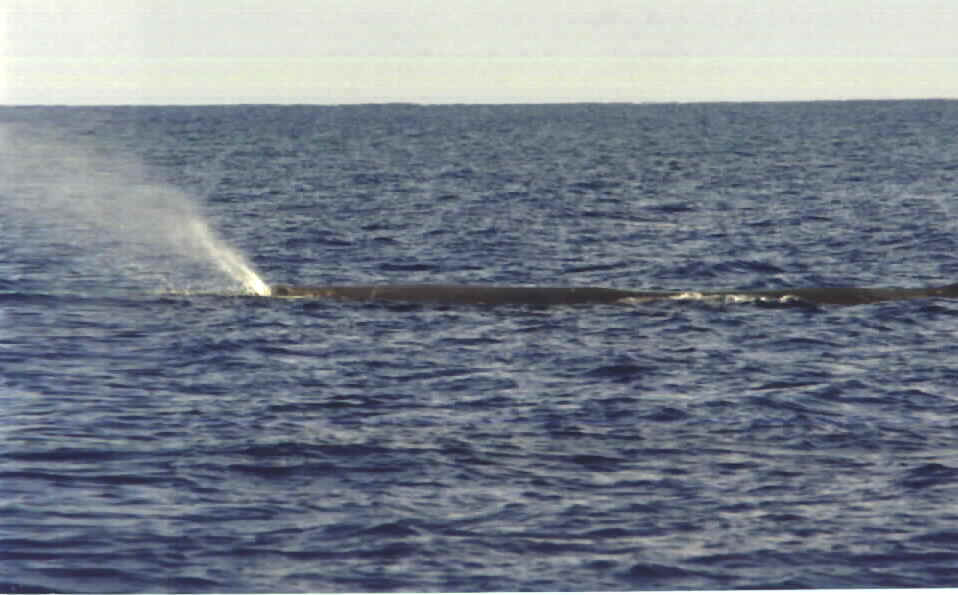

Two photos of Great Sperm Whales during FONT
North Carolina pelagic trips.
In the upper photo, note the characteristic angled spout.
In the lower photo, showing 2 whales, not one with the distinctive log-like
appearance.
This species has also been seen during FONT tours in the Caribbean (off
Dominica)
and off the coast of southern Spain.
SINGLE-TOOTHED WHALES (Family MONODONTIDAE)
There are 3 species worldwide.
- Beluga (t3) ______ AK
Delphinapterus leucas (the single member of its genus)
- Narwhal ______
Monodon monoceros
(the single member of its genus)
BALEEN WHALES -
whales without teeth
(Suborder
Mysticeti)
GRAY WHALE (Family Eschrichtiidae)
- (California) Gray Whale (*) ______
AK CA WA (p) (Other names:
"Mussel-digger", "Scrag Whale")
Eschrichtius robustus
(the single member of its genus)
Females Gray Whales are larger than males: females up to over 46 feet long, males up
to over 42 feet long; the animal's weight can be up to 33 tons.
During a FONT tours near Nome, Alaska, the Gray Whale has been seen from
shore.
The Gray Whale has a 12,000 mile round-trip migration between its southern breeding
grounds in Baja California and its northern feeding grounds in the Bering,
Chukchi, and western Beaufort Seas.
Gray Whales
formerly occurred in the North Atlantic, where they were hunted to
extinction by the 17th or 18th Century. In the western Pacific, a population
off Korea, may now be extinct. The eastern Pacific population was reduced to
only a few hundred or thousand in the early 1900's.Protection came in 1946,
and that population has now recovered.
RIGHT & BOWHEAD WHALES (Family BALAENIDAE)
- North Atlantic Right Whale (t2) (ph) (*)
______ NJ (p)
Balaena (formerly Eubalaena) glacialis


Two photographs of the
rare & endangered North Atlantic Right Whale
off the East Coast of North America.
The counterpart in the Southern Atlantic, the Southern Right Whale,
has been seen during FONT tours in Argentina.
- Bowhead Whale ______ AK (in the Arctic Ocean)
Balaena mysticetus
RORQUAL (or FINBACK) WHALES (Family Balaenopteridae)
- Humpback Whale (ph) (*) ______
AK CA NF NJ WA (p)
Megaptera novaeanliae (the single member of its genus)
Humpback Whales are up to over 52 feet in length, weighing up to 44
tons.

Humpback Whale
- Northern Minke Whale (ph) (*) ______
AK NC NJ WA
(p) (has also been called Piked Whale or
Lesser Rorqual)
Balacnoptera acutorostrata
Formerly, until 1998, the Northern Minke Whale was considered conspecific with southern population,
now the Antarctic Minke Whale, B.
bonaerensis.
The Northern Minke Whale is up to about 30 feet in length,
weighing up to nearly 10 tons.

Northern Minke Whale
- Bryde's Whale ______
Balaenoptera edeni
- Sei Whale (t2) ______ AK
Balaenoptera borealis
- Fin Whale (t2) (ph) (*) ______
AK DE NJ (p)
(has also been called Common Rorqual)
Balaenoptera physalus
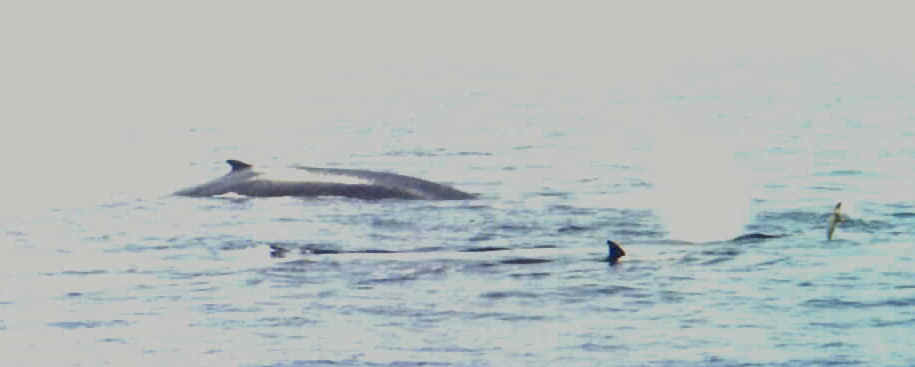
A Fin Whale during a FONT pelagic trip, off the
East Coast of North America
- Blue Whale (t2) (ph) (*) ______
AK CA (p)
(has also been called "Sulphurbottom")
Balaenoptera m. musculus
(subspecies in the North Atlantic
& North Pacific Oceans; 2 other subspecies in the Southern
Hemisphere)
The Blue Whale is the largest of all mammals.

Above & below: the Blue Whale
The photo below during a FONT tour in 2012.
(upper photo by Armas Hill; lower photo by Gabi Hauser)

References for the above mammal-list include:
"Mammals of North America" by Roland W. Kays & Don E. Wilson,
published by Princeton Univ Press, 2002.
"The Encyclopedia of Mammals", edited by Dr. David Macdonald, updated
in 2006.
"Mammals of the World - A Checklist", by Andrew Duff &
Ann Lawson, 2004
"A Field Guide to the Mammals (of North America north of Mexico), by
William H. Burt & Richard P. Grossenheider
"Mammals of the Pacific Northwest", by James R. Christensen & Earl
J. Larrison, 1982
"Marine Birds and Mammals of Puget Sound", by Tony Angell &
Kenneth C. Balcomb, 1982
"Eyewitness Handbook: Whales, Dolphins & Porpoises - a Visual Guide to
the World's Cetaceans", by Mark Carwardine, illustrated by Martin Camm,
1995
"World Guide to Mammals" by Nicole Duplaix
& Noel Simon, 1976
"A Field Guide to the Mammals of Central America & Southeast
Mexico", by Fiona A. Reid, 1997
















































































